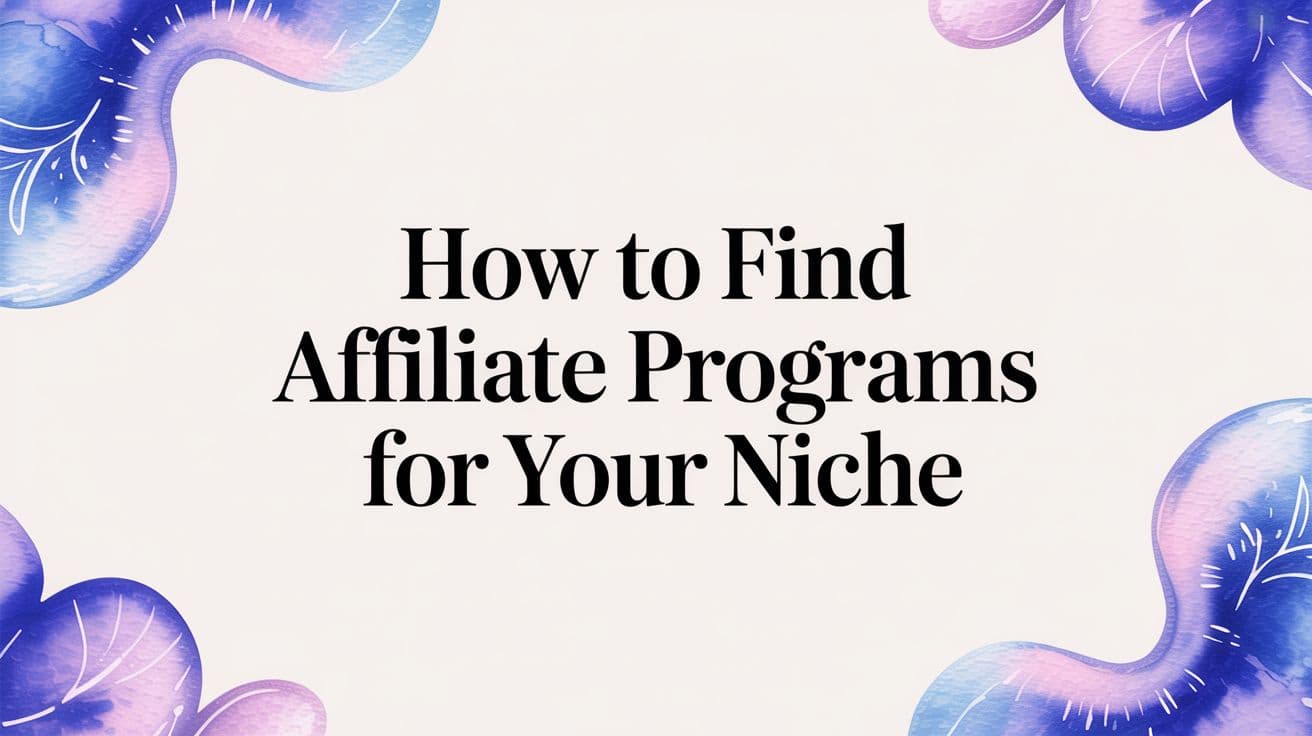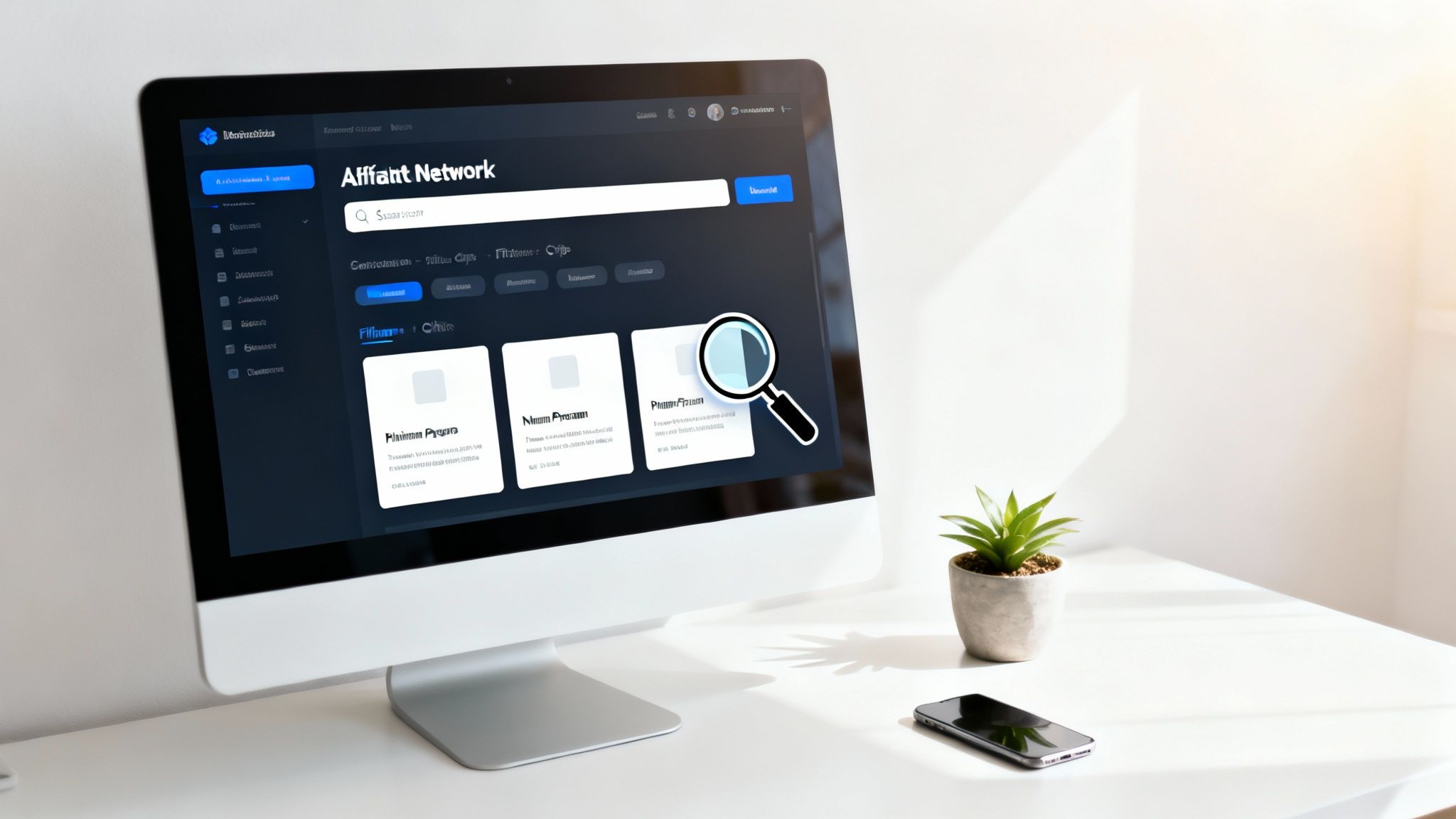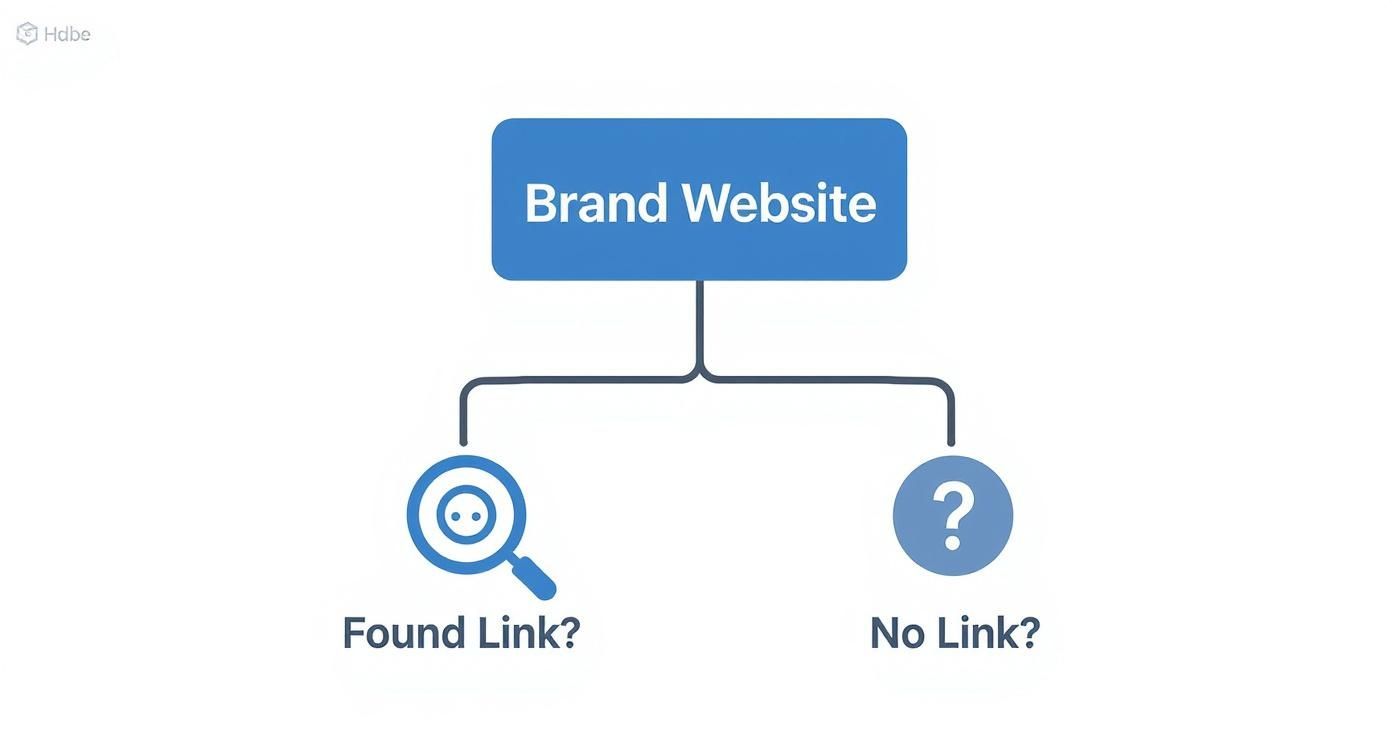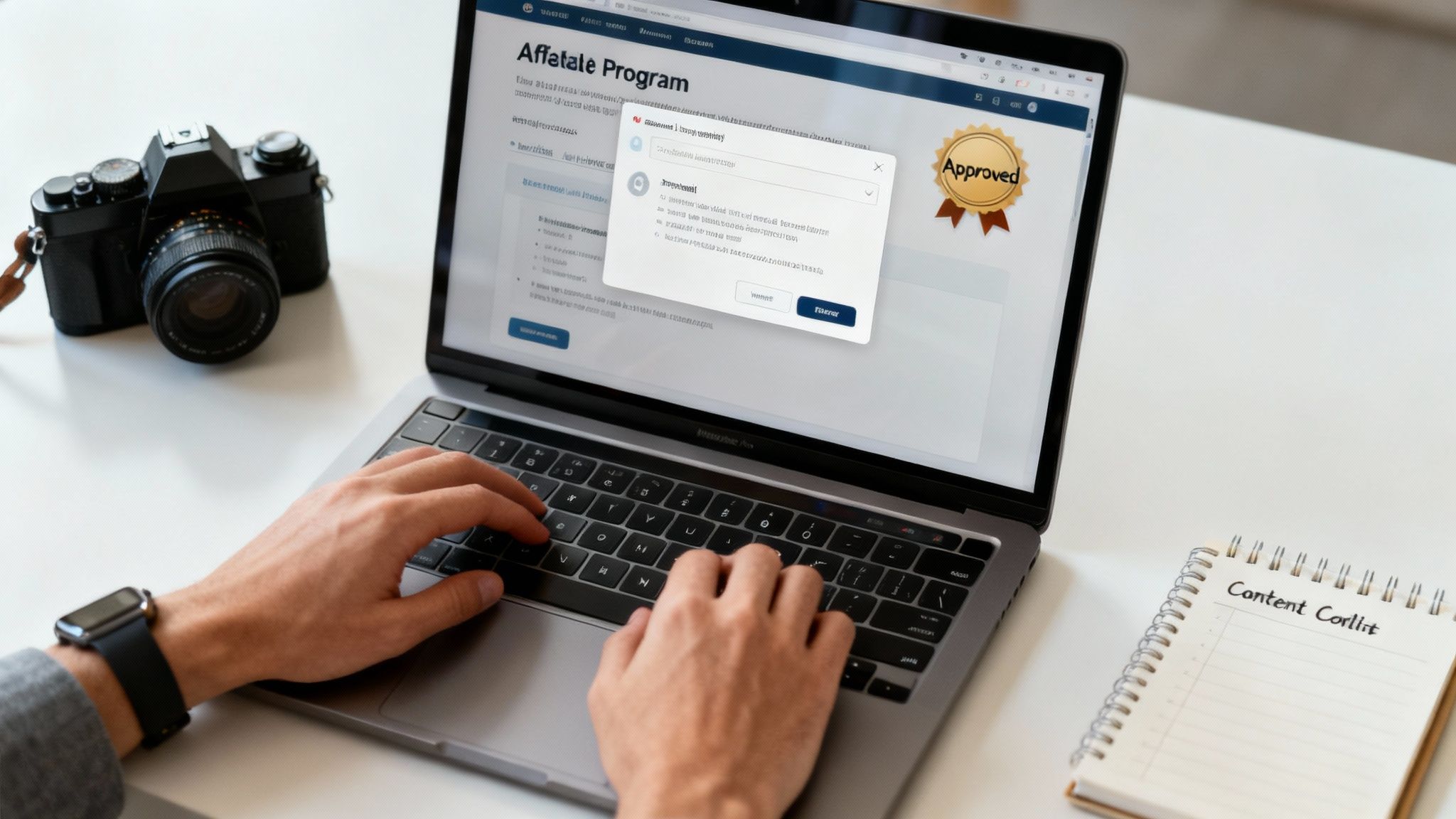How to Find Affiliate Programs for Your Niche
How to Find Affiliate Programs for Your Niche
Ollie Efez
October 25, 2025•16 min read

Finding the right affiliate program doesn't have to be a shot in the dark. The secret? Start by looking at what the successful creators in your niche are already promoting. This competitor-first approach is all about strategic observation, letting you piggyback on what’s already proven to work with your target audience.
Start by Investigating Your Competitors

Before you get lost in huge affiliate networks or endless directories, do a little recon work. It's the most effective way to start.
Take a look at the creators, bloggers, and YouTubers who are already talking to the audience you want to reach. What tools are they constantly recommending? What software pops up in their tutorials? These are your first and best clues.
This method is so effective because it’s based on real-world success. If a top creator in your space is pushing a specific SaaS product, that’s a massive signal. It tells you the product is relevant, and the affiliate program is probably worth your time. You’re essentially using their hard-earned research to build your own list of prospects.
Pinpoint Top Creators and Their Go-To Partners
First things first, make a list of 5-10 influential creators or websites in your niche. They don't have to be direct competitors—just trusted sources your ideal audience listens to.
With your list ready, start exploring their sites. Look for patterns in what they recommend.
Pay special attention to these goldmines:
- "Resources" or "Tools" Pages: Many creators have a dedicated page listing the software and services they swear by. These are almost always packed with affiliate links.
- Product Reviews and Comparisons: In-depth reviews are the bread and butter of affiliate marketing. Take note of which products get glowing reviews and are linked out to again and again.
- Blog Post Disclosures: Keep an eye out for disclaimers like, "This post contains affiliate links." This is your confirmation that they're in a partnership for the products they're talking about.
Going through this process will hand you a pre-vetted list of companies that are not only relevant but also actively looking to work with creators just like you.
Key Takeaway: Analyzing your competitors' affiliate relationships is the fastest way to build a list of high-potential programs. You're simply identifying partnerships that are already a proven success with your target audience.
Use Smart Searches to Dig Up Program Details
Once you spot a product a creator is promoting, a quick Google search is all you need to uncover the details of its affiliate program. The trick is to use specific search queries to cut through the noise.
For example, let's say you see a creator recommending a project management tool called "TaskFlow." You’d search for terms like:
- "TaskFlow affiliate program"
- "TaskFlow partner program"
- "Become a TaskFlow affiliate"
This direct approach usually takes you straight to the affiliate sign-up page, letting you bypass generic, often outdated lists.
This initial research is more important than ever. The affiliate industry is booming, with projections hitting over $37 billion by 2025. A big reason for this is that affiliate marketing now drives around 16% of all online orders in major markets. Discover more affiliate marketing insights on Wix.com. Taking a smart, strategic approach from day one sets you up to grab your piece of this growing pie.
Diving Into Affiliate Networks and Directories

Okay, so you've done a little recon on your competitors. Now it's time to head to the big marketplaces where thousands of brands are actively looking for partners just like you.
These are called affiliate networks, and they're essentially massive hubs connecting creators with companies. Think of them as the Amazon for affiliate partnerships—a one-stop shop.
Giants like ShareASale, CJ Affiliate, and Impact are the names you'll see pop up constantly. Instead of chasing down individual programs one by one, you can browse huge catalogs of brands all in one place. It's an incredibly efficient way to find opportunities you might have otherwise missed.
Getting the Most Out of Network Searches
Just signing up for a network isn't enough. The real magic happens when you master their search and filtering tools to cut through the noise and pinpoint programs that actually align with your audience. Don't just scroll endlessly.
Here’s how to use their features like a pro:
- Filter by Category: Start broad. Narrow your search to a specific category like "Software" or "Digital Marketing Tools." This is the quickest way to get rid of all the stuff that doesn't matter.
- Search by Keyword: Get specific. If your content is all about project management, try searching for terms like "productivity tools," "collaboration software," or "Gantt chart."
- Sort by Performance: This is a big one. Look for options to sort programs by EPC (Earnings Per Click) or Conversion Rate. A high EPC is a great sign that other affiliates are actually making money with that offer.
Once you find a program that looks promising, dig into its profile. This is where you'll find the nitty-gritty details: the commission rate, cookie duration, and any rules or requirements for joining. Some programs are picky and might only accept partners with a certain amount of traffic or a well-established website.
Expert Tip: Keep an eye out for a program's "Power Rank" or a similar internal score on the network. A high rank is usually a good indicator that the company pays on time and provides solid support for its affiliates—two things you definitely want.
To give you a head start, I've put together a quick comparison of some of the most popular networks. This should help you figure out where to begin your search based on your specific niche.
Top Affiliate Networks at a Glance
This table is just a starting point, of course. The best way to find the right fit is to sign up and start exploring what each one has to offer.Don't Forget About Curated Directories
Beyond the massive networks, you'll find curated affiliate directories, which are an absolute goldmine. These are usually smaller, niche-specific lists put together by industry experts.
Unlike the sprawling networks, these directories value quality over quantity. They often feature top-tier SaaS and digital product programs that are much harder to discover on your own. A simple search for "[your niche] + affiliate program directory" can uncover some real hidden gems.
For a deeper dive, our guide on the best affiliate marketing platforms breaks down the pros and cons of different networks and directories. It’s a great resource for deciding where to focus your energy first. Think of directories as your shortcut to pre-vetted, high-quality programs.
Finding the Hidden Gems: How to Uncover High-Value In-house Programs
Affiliate networks are great for casting a wide net, but don't stop there. Some of the most lucrative partnerships I've ever had were the ones I found by going straight to the source.
These are called in-house affiliate programs, and they're run directly by the companies themselves. Think of it this way: you’re cutting out the middleman. This often translates into better support, a real relationship with the brand, and frankly, higher commission rates because they aren't paying network fees. It’s a classic win-win.
Put on Your Detective Hat and Search Their Website
The easiest way to start is by looking for programs from the brands you already know, use, and genuinely love. If you’re a true fan of a SaaS tool or digital product, your recommendation will feel authentic because it is authentic.
Jot down a list of your go-to tools and head over to their websites. You’ll have to do a little digging, but most companies don't hide these links if they have a program.
Here are the usual hiding spots:
- The Website Footer: This is my first stop, every single time. Scroll to the very bottom of the page and scan for links like "Affiliates," "Partners," or "Refer a Friend."
- The Main Navigation: Sometimes, a company is really proud of its partner program and will feature it right in the main header or one of the dropdown menus.
- A Quick Site Search: Still can't find it? Don't give up. Just use their on-site search bar and type in "affiliate program." You'd be surprised how often this works.
Pro Tip: If you strike out, don't assume they don't have a program. Many of the best SaaS companies keep their programs private or invite-only. A well-crafted email can sometimes get you a foot in the door when others can't.
Don't Be Afraid to Reach Out Directly
So, what happens when your absolute favorite company seems to have no public affiliate page? This is where a little initiative pays off. A polite, professional email can open doors you didn’t even know were there.
Find the contact info for their marketing or partnerships team and send a short, friendly message. Introduce yourself, tell them why you're a massive fan of their product, and give them a quick snapshot of your audience. This shows you’re serious and have a genuine interest, which can lead to exclusive deals.
This direct approach works especially well in high-ticket niches. For instance, software affiliate marketers pull in an average of nearly $6,000 per month, and a huge part of that comes from nurturing relationships with these high-value brands. Companies are actively looking for partners beyond the big networks, and as these affiliate marketing statistics from Wix.com show, being proactive is how you tap into that potential.
Evaluating and Choosing the Right Affiliate Partner
So you've got a list of potential affiliate programs. Great! But that’s just the first step. Now comes the real work: digging through that list to find genuine partners that actually fit your brand and, more importantly, will make you money.
It’s tempting to just pick the program with the highest commission rate, but that’s a rookie mistake. A truly great partnership is about way more than a single number. It’s about creating a situation where you win, your audience wins, and the brand wins. This takes a bit of detective work and a clear-headed approach.
Look Beyond the Commission Rate
The commission is obviously a big deal, but it's only one part of the story. Think about it: a 20% recurring commission on a SaaS tool that your audience pays for every month is almost always better than a flashy 40% one-time commission on a product they'll only buy once.
To really understand what you’re signing up for, you have to look at the whole package.
- Commission Type: Is it a one-off payment, or will you earn recurring commissions? For any subscription product, a recurring model is the holy grail. It creates a steady, predictable income stream that you can build on over time.
- Cookie Duration: This is a big one. It's the length of time your affiliate cookie stays active after someone clicks your link. A 90-day cookie gives your audience plenty of time to think it over and still gives you credit for the sale. A 24-hour cookie? Not so much.
- Payment Terms and Thresholds: When do you get paid, and how much do you need to earn first? Some programs have a high payout threshold, like $200, which could mean waiting months to see your first dollar if you're just starting out.
If you want to dive deeper into what’s standard, our guide on typical affiliate marketing commission rates is a great resource for benchmarking different niches.
A strong affiliate partnership is built on mutual benefit. Look for programs with fair terms, solid products, and a genuine commitment to their partners' success—not just the ones flashing the biggest numbers.
Assess Product Relevance and Brand Reputation
There's no faster way to lose your audience's trust than by promoting a product that makes no sense for them. Every single thing you recommend should feel like a natural fit for your content and solve a real problem for the people who follow you.
Before you jump in, honestly ask yourself: does this product add real value? If you wouldn't use it yourself or feel great about recommending it to a friend, it’s a hard pass. The brand's reputation is your reputation by extension. A quick Google search for reviews can uncover red flags like terrible customer service or a buggy product—issues that will absolutely reflect on you.
This decision tree shows the simple process of checking a brand's website for an in-house program first, which is always the best place to start.

As the graphic shows, your first move should always be to go straight to the source—the company's own website—to find the most direct and often most lucrative partnership.
With 81% of brands now running affiliate programs, you have plenty of options. This makes it easier than ever to find reputable partners that you actually feel good about working with. You can learn more about these affiliate marketing trends to see just how big this has become. Taking the time to choose wisely is what separates a small side hustle from a sustainable, long-term business.
Getting In and Getting Paid: Joining and Promoting Your Programs

You've done the hard work of finding and vetting the right programs. Great! But getting accepted and actually earning that first commission is where the real fun starts. Your application is your first impression, so make it count. This is your chance to show you’re a serious partner, not just another random applicant.
Don't just breeze through the sign-up form. Instead of a bland "I have a blog," get specific and sell yourself. Explain who your audience is, where your traffic comes from, and exactly how you plan to promote their product. For example, tell them you're planning a series of in-depth tutorials, a video walkthrough, or a feature in your weekly newsletter. This proves you've already got a game plan.
Making Sense of Your Affiliate Dashboard
Once you get that "welcome aboard" email, you'll gain access to the affiliate dashboard. Think of it as your mission control for tracking everything and grabbing your promo materials. It might look a little overwhelming at first, but you only need to focus on two things to get started: your unique tracking links and the creative assets.
Your affiliate link is your money-maker. It has a unique ID that makes sure you get credit for every sale. Most platforms let you create "deep links," which is just a fancy way of saying you can link to a specific page—not just the homepage. Always use deep links when you can. Sending someone directly to a product page instead of the homepage makes a massive difference in conversion rates.
Next, poke around in the creative assets. This is where the company gives you a bunch of ready-to-use resources to make your life easier. You'll typically find things like:
- Logos and Banners: Professionally designed graphics you can drop onto your website or social media.
- Email Swipe Copy: Pre-written email templates you can tweak for your own list. A huge time-saver.
- Product Screenshots: High-res images perfect for tutorials and reviews that show the product in action.
My Two Cents: Treat every affiliate application like a job interview. Be professional, be specific, and show them why you're a good bet. Once you're in, get comfortable with deep linking—it’s a simple trick that will boost your conversions.
How to Promote Without Being 'That Guy'
Just slapping a banner ad in your sidebar and hoping for the best is a recipe for failure. The affiliates who make real money are the ones who weave promotions into their content so seamlessly that it feels like a genuine recommendation, not a sales pitch. Your audience trusts you for a reason; your promotions should honor that trust.
The secret is to create content that solves a real problem for your audience, where the product you're promoting is the natural solution. For instance, don't just write a generic review of a SaaS tool. Instead, create a detailed tutorial showing how you use it to get a specific result. This provides way more value and shows off the product's benefits in a practical context.
Another smart move is to team up with other creators. Finding the right people to collaborate with can expand your reach exponentially. If you need some pointers, you can learn how to find bloggers and start building partnerships. At the end of the day, authentic, helpful content is what builds a reliable affiliate income.
Got Questions About Finding Affiliate Programs?
As you dive into the world of affiliate marketing, you're bound to have some questions. It can feel like there are a lot of moving parts, but the fundamental ideas are pretty simple once you get the hang of them. Let's tackle some of the most common questions creators have when they're just starting out.
Getting these basics down from the start will help you sidestep common mistakes and pick partners that are actually a good fit for your brand and your audience.
Do I Really Need a Website to Start Affiliate Marketing?
Nope, you absolutely don't. While having your own website is a fantastic long-term asset, it’s far from the only game in town. I've seen plenty of successful affiliates build their entire business on social media.
Platforms like YouTube, Instagram, TikTok, and even Pinterest can be goldmines for promoting products. The same goes for building a dedicated email list or a popular podcast. The magic isn't in the platform itself, but in the engaged following you cultivate. Just make sure you're always playing by the rules—both the social platform's and the affiliate program's.
How Many Affiliate Programs Should I Join at First?
When you're new, it's all about quality over quantity. It's tempting to go on a signing spree and join every program that looks interesting, but trust me, that's a mistake.
My Advice: Start by focusing on just 1-3 core programs that you know your audience will love. This gives you the space to truly learn the products, create amazing content around them, and promote them in a way that feels genuine. You won't overwhelm your followers, and you'll get better results.
Once you’ve got a good rhythm going and you're seeing consistent commissions, then you can start looking for other complementary products to add to your rotation. A focused approach beats a scattered one every time.
What's the Difference Between an In-House Program and a Network?
This is a really important distinction, as it affects everything from your commissions to your day-to-day management.
- An affiliate network is basically a big marketplace. Think of platforms like ShareASale or Impact. They bring together thousands of different brands under one roof and handle all the tracking, reporting, and payments for you. They’re super convenient and offer tons of options.
- An in-house program is run directly by the company selling the product. They manage everything themselves. By cutting out the network (the middleman), these programs can often afford to offer higher commissions and a more direct line of communication with an affiliate manager.
So, while networks give you variety, going direct with an in-house program can sometimes lead to better deals and a stronger partnership.
How Can I Tell if a Niche Is Actually Profitable?
A profitable niche usually comes down to a mix of three things:
- Audience Demand: Are people actively searching for solutions and information on this topic?
- Good Products Exist: Are there quality SaaS tools, courses, or digital products available that also have affiliate programs?
- People Are Willing to Pay: Does the audience see the value in paying for a good solution, or are they only looking for freebies?
A great way to start is by seeing what successful creators in that niche are already promoting. Use keyword tools to see if people are searching for product reviews or "best of" lists. Niches built around subscription products (hello, recurring revenue!) or high-ticket items tend to have the biggest income potential.
Ready to launch your own affiliate program? LinkJolt gives you all the tools you need to create, manage, and scale your partnerships effortlessly. Set up in minutes, track every click, and automate payouts with zero transaction fees. Find out why top SaaS companies trust us to grow their revenue at https://linkjolt.io.
Watch Demo (2 min)
Trusted by 100+ SaaS companies
Start Your Affiliate Program Today
Get 30% off your first 3 months with code LINKJOLT30
✓ 3-day free trial
✓ Cancel anytime